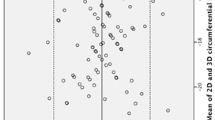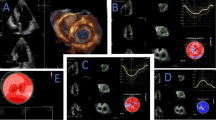Abstract
Two-dimensional strain (2DS) is a novel method to measure strain from standard two-dimensional echocardiographic images by speckle tracking, which is less angle dependent and more reproducible than conventional Doppler-derived strain. The objective of our study was to characterize global and regional function abnormalities using 2DS and strain rate analysis in patients (pts) with pathological left ventricular hypertrophy (LVH) caused by non-obstructive hypertrophic cardiomyopathy (HCM), in top level athletes, and in healthy controls. The hypothetical question was, if 2DS might be useful as additional tool in differentiating between pathologic and physiologic hypertrophy in top-level athletes. We consecutively studied 53 subjects, 15 pts with hypertrophic cardiomyopathy (HCM), 20 competitive top-level athletes, and a control group of 18 sedentary normal subjects by standard echocardiography according to ASE guidelines. Global longitudinal strain (GLS) and regional peak systolic strain (PSS) was assessed by 2DS in the apical four-chamber-view using a dedicated software. All components of strain were significantly reduced in pts with HCM (GLS: −8.1 ± 3.8%; P < 0.001) when compared with athletes (−15.2 ± 3.6%) and control subjects (−16.0 ± 2.8%). In general, there was no significant difference between the strain values of the athletes and the control group, but in some of the segments, the strain values of the control group were significantly higher than those in the athletes. A cut-off value of GLS less than −10% for the diagnosis of pathologic hypertrophy (HCM) resulted in a sensitivity of 80.0% and a specificity of 95.0%. The combination of TDI (averaged S′, E′) and 2DS (GLS) cut-off values for the detection of pathologic LVH in HCM demonstrated a sensitivity of 100%, and a specificity of 95%. Two-dimensional strain is a new simple and rapid method to measure GLS and PSS as components of systolic strain. This technique could offer a unique approach to quantify global as well as regional systolic dysfunction, and might be used as new additional tool for the differentiation between physiologic and pathologic LVH.


Similar content being viewed by others
Abbreviations
- 2DS:
-
Two-dimensional strain
- A:
-
Late component of the transmitral inflow pattern
- A′:
-
Late diastolic velocity of the mitral annulus (TDI)
- DT:
-
Deceleration time of E
- E:
-
Early component of the transmitral inflow pattern
- E′:
-
Early diastolic velocity of the mitral annulus (TDI)
- E/E′ ratio:
-
Ratio of the early component of the transmitral inflow pattern and the early diastolic velocity of the mitral annulus
- E′/E ratio:
-
Ratio of the early diastolic velocity of the mitral annulus and the early component of the transmitral inflow pattern
- GFI:
-
Global function index; GFI = (E/E′)/S′ [s × cm−1]
- GLS:
-
Global longitudinal strain
- HCM:
-
Hypertrophic cardiomyopathy
- IVSED:
-
End diastolic thickness of the interventricular septum
- LV:
-
Left ventricular
- LVEDD:
-
Left ventricular enddiastolic diameter
- LVH:
-
Left ventricular hypertrophy
- MA:
-
Mitral annulus
- PSS:
-
Regional peak systolic strain
- PWED:
-
End diastolic thickness of the posterior wall
- S′:
-
Systolic velocity of the mitral annulus (TDI)
- TDI:
-
Tissue Doppler imaging
References
Corrado D, Pelliccia A, Bjørnstad HH, Vanhees L, Biffi A, Borjesson M et al (2005) Cardiovascular pre-participation screening of young competitive athletes for prevention of sudden death: proposal for a common European protocol. Consensus Statement of the Study Group of Sport Cardiology of the Working Group of Cardiac Rehabilitation and Exercise Physiology and the Working Group of Myocardial and Pericardial Diseases of the European Society of Cardiology. Eur Heart J 26:516–524
Rawlins J, Bhan A, Sharma S (2009) Left ventricular hypertrophy in athletes. Eur J Echocardiogr 10(3):350–356
Serri K, Reant P, Lafitte M, Berhouet M, Le Bouffos V, Roudaut R, Lafitte S (2006) Global and regional myocardial function quantification by two-dimensional strain: application in hypertrophic cardiomyopathy. J Am Coll Cardiol 47(6):1175–1181
Saghir M, Areces M, Makan M (2007) Strain rate imaging differentiates hypertensive cardiac hypertrophy from physiologic cardiac hypertrophy (athlete’s heart). J Am Soc Echocardiogr 20(2):151–157
Yang H, Sun JP, Lever HM, Popovic ZB, Drinko JK, Greenberg NL, Shiota T, Thomas JD, Garcia MJ (2003) Use of strain imaging in detecting segmental dysfunction in patients with hypertrophic cardiomyopathy. J Am Soc Echocardiogr 16(3):233–239
Nagueh SF, Bachinski LL, Meyer D, Hill R, Zoghbi WA, Tam JW et al (2001) Tissue Doppler imaging consistently detects myocardial abnormalities in patients with hypertrophic cardiomyopathy and provides a novel means for an early diagnosis before and independently of hypertrophy. Circulation 104:128–130
Nagueh SF, McFalls J, Meyer D, Hill R, Zoghbi WA, Tam JW et al (2003) Tissue Doppler imaging predicts the development of hypertrophic cardiomyopathy in subjects with sub-clinical disease. Circulation 108:395–398
Vinereanu D, Florescu N, Sculthorpe N, Tweddel AC, Stephens MR, Fraser AG (2001) Differentiation between pathologic and physiologic left ventricular hypertrophy by tissue Doppler assessment of long-axis function in patients with hypertrophic cardiomyopathy or systemic hypertension and in athletes. Am J Cardiol 88(1):53–58
Palka P, Lange A, Fleming AD, Donnelly JE, Dutka DP, Starkey IR et al (1997) Differences in myocardial velocity gradient measured throughout the cardiac cycle in patients with hypertrophic cardiomyopathy, athletes and patients with left ventricular hypertrophy due to hypertension. J Am Coll Cardiol 30:760–768
Heimdal A, Stoylen A, Torp H, Skjaerpe T (1998) Real-time strain rate imaging of the left ventricle by ultrasound. J Am Soc Echocardiogr 11:1013–1019
Leitman M, Lysyansky P, Sidenko S, Shir V, Peleg E, Binenbaum M et al (2004) Two-dimensional strain—a novel software for real-time quantitative echocardiographic assessment of myocardial function. J Am Soc Echocardiogr 17:1021–1029
Sutherland GR, Di Salvo G, Claus P, D’Hoogle J, Bijnens B (2004) Strain and strain rate imaging: a new clinical approach to quantifying regional myocardial function. J Am Soc Echocardiogr 17:788–802
Urheim S, Edvardsen T, Torp H, Angelsen B, Smiseth OA (2000) Myocardial strain by Doppler echocardiography: validation of a new method to quantify regional myocardial function. Circulation 102:1158–1164
Marwick TH (2006) Measurement of strain and strain rate by echocardiography. Ready for prime time? J Am Coll Cardiol 47:1313–1327
Ha JW, Ahn AJ, Kim JM, Choi EY, Kang SM, Rim SJ, Jang Y et al (2006) Abnormal longitudinal myocardial functional reserve assessed by exercise tissue Doppler echocardiography in patients with hypertrophic cardiomyopathy. J Am Soc Echocardiogr 19:1314–1319
Popovic ZB, Kwon DH, Mishra M, Buakhamsri A, Greenberg NL, Thamilarasan M et al (2008) Association between regional ventricular function and myocardial fibrosis in hypertrophic cardiomyopathy assessed by speckle tracking echocardiography and delayed hyper-enhancement magnetic resonance imaging. J Am Soc Echocardiogr 21:1299–1305
Poulsen SH, Hjortshøj S, Korup E, Poenitz V, Espersen G, Søgaard P et al (2007) Strain rate and tissue tracking imaging in quantification of left ventricular systolic function in endurance and strength athletes. Scand J Med Sci Sports 17:148–155
Kato TS, Noda A, Izawa H, Yamada A, Obata K, Nagata K, Iwase M, Murohara T, Yokota M (2004) Discrimination of nonobstructive hypertrophic cardiomyopathy from hypertensive left ventricular hypertrophy on the basis of strain rate imaging by tissue Doppler ultrasonography. Circulation 110(25):3808–3814
Richand V, Lafitte S, Reant P, Serri K, Lafitte M, Brette S, Kerouani A, Chalabi H, Dos Santos P, Douard H, Roudaut R (2007) An ultrasound speckle tracking (two-dimensional strain) analysis of myocardial deformation in professional soccer players compared with healthy subjects and hypertrophic cardiomyopathy. Am J Cardiol 100(1):128–132
Núñez J, Zamorano JL, Pérez De Isla L, Palomeque C, Almería C, Rodrigo JL, Corteza J, Banchs J, Macaya C (2004) Differences in regional systolic and diastolic function by Doppler tissue imaging in patients with hypertrophic cardiomyopathy and hypertrophy caused by hypertension. J Am Soc Echocardiogr 17(7):717–722
Araujo AQ, Arteaga E, Ianni BM, Salemi VM, Ramires FJ, Matsumoto AY, Fernandes F, Mady C (2006) Usefulness of a new proposed tissue Doppler imaging global function index in hypertrophic cardiomyopathy. Echocardiography 23(3):197–201
Cheitlin MD, Armstrong WF, Aurigemma GP, Beller GA, Bierman FZ, Davis JL et al. (2003) ACC/AHA/ASE 2003 guideline update for the clinical application of echocardiography: a report of the American College of Cardiology/American Heart Association Task Force on Practice Guidelines (ACC/AHA/ASE Committee to Update the 1997 Guidelines for the Clinical Application of Echocardiography) 2003. Circulation 108:1146–1162. Available at: www.acc.org/clinical/guidelines/echo/index.pdf
Devereux RB (1987) Detection of left ventricular hypertrophy by M-mode echocardiography. Anatomic validation, standardization, and comparison to other methods. Hypertension 9(II):19–26
Butz T, Faber L, Piper C, Langer C, Kottmann T, Schmidt HK, Wiemer M, Körfer R, Horstkotte D (2008) Constrictive pericarditis or restrictive cardiomyopathy? Echocardiographic tissue Doppler analysis. Deutsche Medizinische Wochenschrift 133(9):399–405
Butz T, van Buuren F, Mellwig KP, Langer C, Oldenburg O, Treusch KA, Meissner A, Plehn G, Trappe HJ, Horstkotte D, Faber L (2010) Echocardiographic assessment of systolic and early diastolic left ventricular velocities in 100 top-level handball player by tissue Doppler imaging. Eur J Cardiovasc Prev Rehabil 17:342–348
Butz T, Piper C, Langer C, Wiemer M, Kottmann T, Meissner A, Plehn G, Trappe HJ, Horstkotte D, Faber L (2010) Diagnostic superiority of a combined assessment of the systolic and early diastolic mitral annular velocities by tissue Doppler imaging for the differentiation of restrictive cardiomyopathy from constrictive pericarditis. Clin Res Cardiol 99(4):207–215
Jategaonkar SR, Scholtz W, Butz T, Bogunovic N, Faber L, Horstkotte D (2009) Two-dimensional strain and strain rate imaging of the right ventricle in adult patients before and after percutaneous closure of atrial septal defects. Eur J Echocardiogr 10(4):499–502
Ommen SR, Nishimura RA, Appleton CP et al (2000) Clinical utility of Doppler echocardiography and tissue Doppler imaging in the estimation of left ventricular filling pressures: A comparative simultaneous Doppler-catheterization study. Circulation 102:1788–1794
Nagueh SLN, Middleton C, Spencer W, Zoghbi W, Quinones M (1999) Doppler estimation of left ventricular filling pressures in patients with hypertrophic cardiomyopathy. Circulation 99:254–261
Faber L, Muntean BG, Butz T, Welge D, Hering D, Horskotte D (2007) Regional peak systolic strain assessed by 2D strain analysis (2DS) in patients with aortic valve stenosis (AS) and obstructive hypertrophic cardiomyopathy (HOCM). Eur J Echocardiogr 8:S138
Reckefuss N, Butz T, Langer C, Jategaonkar S, Bogunovic N, Kroeger K, Horstkotte D, Faber L (2008) Two-dimensional strain (2D-strain): evaluation of systolic longitudinal and radial strain in a large cohort of normal probands. J Am Coll Cardiol 51(Suppl A):A106
Conflict of interest statement
None.
Author information
Authors and Affiliations
Corresponding author
Rights and permissions
About this article
Cite this article
Butz, T., van Buuren, F., Mellwig, K.P. et al. Two-dimensional strain analysis of the global and regional myocardial function for the differentiation of pathologic and physiologic left ventricular hypertrophy: a study in athletes and in patients with hypertrophic cardiomyopathy. Int J Cardiovasc Imaging 27, 91–100 (2011). https://doi.org/10.1007/s10554-010-9665-5
Received:
Accepted:
Published:
Issue Date:
DOI: https://doi.org/10.1007/s10554-010-9665-5




